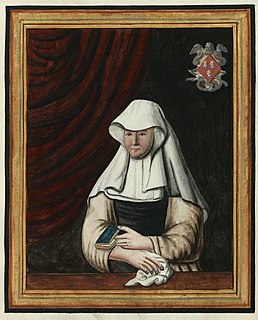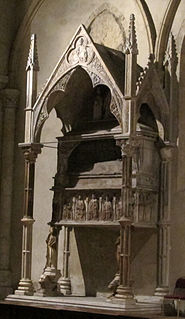Related Research Articles
Catharism was a Christian dualist or Gnostic movement between the 12th and 14th centuries which thrived in Southern Europe, particularly in northern Italy and southern France. Followers were described as Cathars and referred to themselves as Good Christians, and are now mainly remembered for a prolonged period of religious persecution by the Catholic Church, which did not recognize their unorthodox Christianity. Catharism arrived in Western Europe in the Languedoc region of France in the 11th century. The adherents were sometimes referred to as Albigensians, after the city Albi in southern France where the movement first took hold. The belief may have originated in the Byzantine Empire. Catharism was initially taught by ascetic leaders who set few guidelines and so some Catharist practices and beliefs varied by region and over time. The Catholic Church denounced its practices, including the consolamentum ritual by which Cathar individuals were baptised and raised to the status of "Perfect".

The Inquisition, in historical ecclesiastical terminology also referred to as the "Holy Inquisition", was a group of institutions within the Catholic Church whose aim was to combat heresy, conducting trials of suspected heretics. Studies of the records have found that the overwhelming majority of sentences consisted of penances, but that cases of repeat unrepentant heretics were handed over to the secular courts, which generally resulted in execution or life imprisonment. The Inquisition had its start in 12th-century Kingdom of France, with the aim of combating religious deviation, particularly among the Cathars and the Waldensians. The inquisitorial courts from this time until the mid-15th century are together known as the Medieval Inquisition. Other groups investigated during the Medieval Inquisition, which primarily took place in France and Italy, including the Spiritual Franciscans, the Hussites, and the Beguines. Beginning in the 1250s, inquisitors were generally chosen from members of the Dominican Order, replacing the earlier practice of using local clergy as judges.

The Medieval Inquisition was a series of Inquisitions from around 1184, including the Episcopal Inquisition (1184–1230s) and later the Papal Inquisition (1230s). The Medieval Inquisition was established in response to movements considered apostate or heretical to Roman Catholicism, in particular Catharism and Waldensians in Southern France and Northern Italy. These were the first movements of many inquisitions that would follow.

Charles IV, called the Fair in France and the Bald in Navarre, was last king of the direct line of the House of Capet, King of France and King of Navarre from 1322 to 1328. Charles was the third son of Philip IV; like his father, he was known as "the fair" or "the handsome".

Jacques de Molay, also spelled "Molai", was the 23rd and last grand master of the Knights Templar, leading the order from 20 April 1292 until it was dissolved by order of Pope Clement V in 1312. Though little is known of his actual life and deeds except for his last years as Grand Master, he is one of the best known Templars.

The House of Capet or the Direct Capetians, also called the House of France, or simply the Capets, ruled the Kingdom of France from 987 to 1328. It was the most senior line of the Capetian dynasty – itself a derivative dynasty from the Robertians. Historians in the 19th century came to apply the name "Capetian" to both the ruling house of France and to the wider-spread male-line descendants of Hugh Capet. Contemporaries did not use the name "Capetian". The Capets were sometimes called "the third race of kings". The name "Capet" derives from the nickname given to Hugh, the first Capetian king.

The Beguines and the Beghards were Christian lay religious orders that were active in Western Europe, particularly in the Low Countries, in the 13th–16th centuries. Their members lived in semi-monastic communities but did not take formal religious vows; although they promised not to marry "as long as they lived as Beguines," to quote one of the early Rules, they were free to leave at any time. Beguines were part of a larger spiritual revival movement of the 13th century that stressed imitation of Jesus' life through voluntary poverty, care of the poor and sick, and religious devotion.
Dame Alice Kyteler was the first recorded person condemned for witchcraft in Ireland. She fled the country, but her servant Petronilla de Meath was flogged and burned to death at the stake on 3 November 1324.
Marguerite Porete was a French-speaking mystic and the author of The Mirror of Simple Souls, a work of Christian mysticism dealing with the workings of agape. She was burnt at the stake for heresy in Paris in 1310 after a lengthy trial, refusing to remove her book from circulation or recant her views.
The Brethren of the Free Spirit were adherents of a loose set of beliefs deemed heretical by the Catholic Church but held by some Christians, especially in the Low Countries, Germany, France, Bohemia, and Northern Italy between the thirteenth and fifteenth centuries. The movement was first identified in the late thirteenth century. It was not a single movement or school of thought, and it caused great unease among Church leaders at the time. Adherents were also called Free Spirits.

Joan of Burgundy, also known as Joan the Lame, was Queen of France as the first wife of King Philip VI. Joan ruled as regent while her husband fought on military campaigns during the Hundred Years' War: 1340, 1345-1346 and 1347.
Na Gormonda de Monpeslier or Montpelher was a trobairitz from Montpellier in Languedoc. Her lone surviving work, a sirventes, has been called "the first French political poem by a woman."
In the historical folklore of Sicily, Doñas de fuera were supernatural female beings comparable to the fairies of English folklore. In the 16th to mid-17th centuries, the donas de fuera also played a role in the witch trials in Sicily.

Marie of Valois, was the eldest daughter of Charles of Valois by his third wife Mahaut of Châtillon. She was a member of the House of Valois. One of her five children was Queen Joanna I of Naples.
Roger Utlagh, or Roger Outlawe was a leading Irish cleric, judge and statesman of the fourteenth century who was Prior of Kilmainham, and held the office of Lord Chancellor of Ireland. He was the brother-in-law of the celebrated Witch of Kilkenny, Alice Kyteler, and is mainly remembered today for his efforts to shield her from prosecution, and subsequently enabling her to escape punishment, during the Kilkenny Witch Trials of 1324.

The Massacre at Béziers was the slaughter of the inhabitants during the sack of Béziers, an event that took place on 22 July 1209, and was the first major military action of the Albigensian Crusade.

Bernard Délicieux was a Spiritual Franciscan friar who resisted the Inquisition in Carcassonne and Languedoc region of southern France.
Guglielma or Wilhelmina of Bohemia was an Italian noblewoman, possibly of Czech/Bohemian origin, according to her own assertions the daughter of king Ottokar I of Bohemia. She practiced and preached an alternative, feminized version of Christianity in which she predicted the end of time and her own resurrection as the Holy Spirit incarnate. She is now the unofficial patron saint of Brunate. A painting from ca. 1450 depicting Guglielma blessing Abbess Maddalena Albrizzi and an unknown donor hangs in the Church of San Andrea in Brunate. Barbara Newman has attempted to identify the kneeling figures in the painting as Guglielma's followers, Sister Maifreda da Pirovano and Andrea Saramita, but this is contested.
Medieval women's mysticism was "a succession of insights and revelations about God that gradually transformed the recipient" according to historian Elizabeth Petroff of Oxford University in her 1994 book, Body and Soul. The word "mysticism" has its origin in ancient Greece where individuals called the mystae participated in mystery religions. The life of a medieval woman mystic was spent seeking unity with God in a series of stages. The mystical life of a medieval woman began with a purge of the spirit in which she released herself from earthly indulgences and attachments. In a state of contrition the medieval woman mystic faced suffering because of her past sins, and the mercy of God was revealed to her through penitence. Mystics sought to imitate the suffering of Christ in order to gain an understanding through experience. During the compassion stage of suffering, the pain experienced by the medieval woman mystic "revealed the believer's love of Christ, fostered unity with Christ and the world, and began to draw the believer beyond the physical Jesus who suffered on the Cross to understand the immensity of the love that motivated Christ in the world to suffer on humanity's behalf". Medieval women mystics experienced visions during what medieval historians refer to as the Illuminative stage of their lives that contained instructions from God and would communicate their revelations in written form.
References
- «Diccionari Biogràfic de Dones: Na Prous Boneta»
- May, William H. (1965). «The confession of Prous Boneta. Heretic and Heresiarch» en John H. Mundy (ed.) Essays in Medieval Life and Thought presented in Honour of Austin Patterson Evans, p. 3-30. New York: Biblo&Tanner.